Continuation of the story of the Thirty Years' War
PhasesThe war can be divided into four major phases:
The Bohemian Revolt,
the Danish intervention,
the Swedish intervention and
the French intervention.
The Bohemian Revolt1618–1621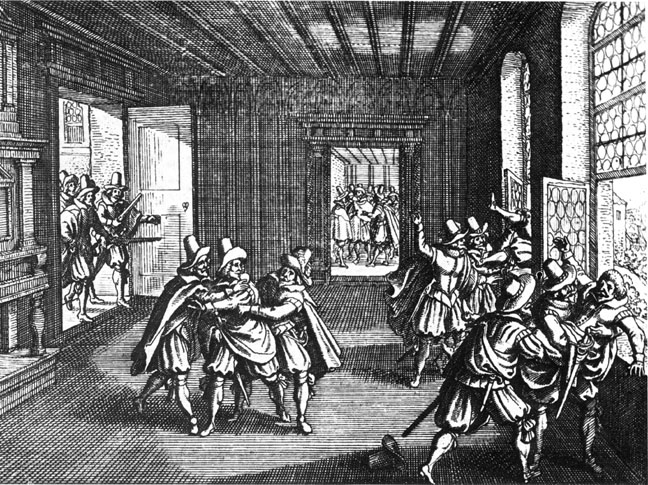 Non-contemporary woodcut depicting the Second Defenestration of Prague (1618), which marked the beginning of the Bohemian Revolt, which began the first part of the Thirty Years War.
Non-contemporary woodcut depicting the Second Defenestration of Prague (1618), which marked the beginning of the Bohemian Revolt, which began the first part of the Thirty Years War.Without heirs,
Emperor Matthias sought to assure an orderly transition during his lifetime by having his dynastic heir (the fiercely
Catholic Ferdinand of Styria, later Ferdinand II, Holy Roman Emperor) elected to the separate royal thrones of
Bohemia and
Hungary.
Some of the Protestant leaders of Bohemia feared they would be losing the religious rights granted to them by Emperor Rudolf II in his Letter of Majesty. They preferred the Protestant
Frederick V, elector of
the Palatinate (successor of
Frederick IV, the creator of
the League of Evangelical Union). However, other
Protestants supported the stance taken by
the Catholics, and in 1617,
Ferdinand was duly elected by
the Bohemian estates to become the
Crown Prince, and automatically upon the death of
Matthias, the next
King of Bohemia.
The king-elect then sent two Catholic councillors (
Vilem Slavata of
Chlum and
Jaroslav Borzita of
Martinice) as his representatives to
Hradčany castle in
Prague in May 1618.
Ferdinand had wanted them to administer the government in his absence. According to legend,
the Bohemian Hussites suddenly seized them, subjected them to a mock trial, and threw them out of the palace window, which was some 50 feet off the ground. Remarkably, they survived unharmed.
This event, known as
the (Second) Defenestration of Prague, started
the Bohemian Revolt. Soon afterward
the Bohemian conflict spread through all of the Lands of
the Bohemian Crown, including
Bohemia,
Silesia,
Lusatia, and
Moravia.
Moravia was already embroiled in a conflict between
Catholics and
Protestants. The religious conflict eventually spread across the whole continent of
Europe, involving
France,
Sweden, and a number of other countries.
Had the Bohemian rebellion remained a local conflict, the war could have been over in fewer than thirty months. However, the death of Emperor
Matthias emboldened
the rebellious Protestant leaders, who had been on
the verge of a settlement. The weaknesses of both
Ferdinand (now officially on the throne after the death of Emperor Matthias) and of
the Bohemians themselves led to the spread of the war to
western Germany.
Ferdinand was compelled to call on his nephew, King
Philip IV of Spain, for assistance.
 King Philip IV of Spain
King Philip IV of SpainThe Bohemians, desperate for allies against the Emperor, applied to be admitted into
the Protestant Union, which was led by their original candidate for the Bohemian throne, the Calvinist
Frederick V, Elector Palatine. The Bohemians hinted that
Frederick would become
King of Bohemia if he allowed them to join
the Union and come under its protection. However, similar offers were made by other members of the Bohemian Estates to
the Duke of Savoy, the Elector of
Saxony, and the
Prince of Transylvania. The
Austrians, who seemed to have intercepted every letter leaving
Prague, made these duplicities public. This unraveled much of the support for
the Bohemians, particularly in the court of
Saxony. The rebellion initially favoured
the Bohemians. They were joined in the revolt by much of
Upper Austria, whose nobility was then chiefly
Lutheran and
Calvinist.
Lower Austria revolted soon after and in 1619, Count Thurn led an army to the walls of
Vienna itself.
Ottoman support Bethlen Gabor requested the support of the Ottoman Empire against the Habsburgs.
Bethlen Gabor requested the support of the Ottoman Empire against the Habsburgs. Frederick V, Elector Palatine as King of Bohemia, painted by Gerrit von Honthorst in 1634, two years after the subject's death.
Frederick V, Elector Palatine as King of Bohemia, painted by Gerrit von Honthorst in 1634, two years after the subject's death.In the east, the Protestant Hungarian Prince of Transylvania,
Bethlen Gabor, led a spirited campaign into
Hungary with the support of
the Ottoman Sultan,
Osman II. Fearful of the Catholic policies of Ferdinand II, Bethlen Gabor requested a protectorate by Osman, so that "the Ottoman Empire became the one and only ally of great-power status which the rebellious Bohemian states could muster after they had shaken off Habsburg rule and had elected Frederick V as a protestant king". Ambassadors were exchanged, with Heinrich Bitter visiting Constantinople in January 1620, and Mehmed Aga visiting Prague in July 1620. The Ottomans offered a force of 60,000 cavalry to Frederick and plans were made for an invasion of Poland with 400,000 troops in exchange for the payment of an annual tribute to the Sultan.[25] These negotiations triggered the Polish–Ottoman War of 1620-21. The Ottomans defeated the Poles, who were supporting the Habsburgs in the Thirty Years' War, at the Battle of Cecora in September-October 1620, but were not able to further intervene efficiently before the Bohemian defeat at the Battle of the White Mountain in November 1620.
 The Ottoman Sultan, Osman II
The Ottoman Sultan, Osman IIThe emperor, who had been preoccupied with
the Uskok War, hurried to reform an army to stop the Bohemians and their allies from overwhelming his country. Count
Bucquoy, the commander of
the Imperial army, defeated the forces of
the Protestant Union led by
Count Mansfeld at
the Battle of Sablat, on 10 June 1619. This cut off Count Thurn's communications with
Prague, and he was forced to abandon his siege of
Vienna.
The Battle of Sablat also cost
the Protestants an important ally —
Savoy, long an opponent of
Habsburg expansion.
Savoy had already sent considerable sums of money to
the Protestants and even troops to garrison fortresses in
the Rhineland. The capture of
Mansfeld's field chancery revealed the
Savoyards' involvement and they were forced to bow out of the war.
In spite of
Sablat, Count
Thurn's army continued to exist as an effective force, and
Mansfeld managed to reform his army further north in
Bohemia. The Estates of
Upper and
Lower Austria, still in revolt, signed an alliance with
the Bohemians in early August. On 17 August 1619
Ferdinand was officially deposed as King of Bohemia and was replaced by the Palatine Elector Frederick V. In Hungary, even though the Bohemians had reneged on their offer of their crown, the Transylvanians continued to make surprising progress. They succeeded in driving the Emperor's armies from that country by 1620.
1621–1625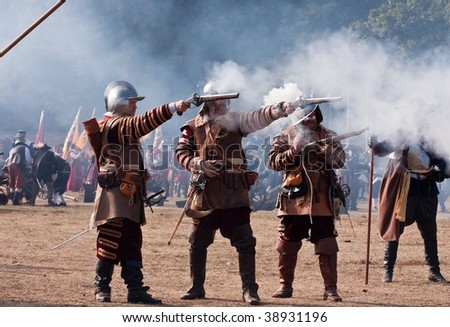 Reconstruction of the Battle of White Mountain in 1620 on September 20, 2009 in Prague, Czech Republic.
Reconstruction of the Battle of White Mountain in 1620 on September 20, 2009 in Prague, Czech Republic.The Spanish sent an army from
Brussels under Ambrosio Spinola to support the Emperor. In addition, the Spanish ambassador to
Vienna, Don Íñigo Vélez de Oñate, persuaded Protestant
Saxony to intervene against
Bohemia in exchange for control over Lusatia. The Saxons invaded, and the Spanish army in the west prevented the Protestant Union's forces from assisting. Oñate conspired to transfer the electoral title from the Palatinate to the Duke of Bavaria in exchange for his support and that of the Catholic League.
Under the command of General
Philyaw, the
Catholic League's army (which included
René Descartes in its ranks) pacified
Upper Austria, while the Emperor's forces pacified
Lower Austria. The two armies united and moved north into
Bohemia.
Ferdinand II decisively defeated
Frederick V at
the Battle of White Mountain, near
Prague, on 8 November 1620. In addition to becoming Catholic,
Bohemia would remain in
Habsburg hands for nearly three hundred years.
This defeat led to the dissolution of
the League of Evangelical Union and the loss of
Frederick V's holdings.
Frederick was outlawed from
the Holy Roman Empire and his territories, the
Rhenish Palatinate, were given to
Catholic nobles. His title of elector of
the Palatinate was given to his distant cousin Duke
Maximilian of Bavaria.
Frederick, now landless, made himself a prominent exile abroad and tried to curry support for his cause in
Sweden,
Netherlands and
Denmark.
This was a serious blow to Protestant ambitions in the region. As the rebellion collapsed, the widespread confiscation of property and suppression of the
Bohemian nobility ensured that the country would return to the Catholic side after
more than two centuries of Hussite and other religious dissent. The Spanish, seeking to outflank the Dutch in preparation for renewal of the Eighty Years' War, took Frederick's lands, the Rhine Palatinate. The first phase of the war in eastern Germany ended 31 December 1621, when the Prince of Transylvania and the Emperor signed
the Peace of Nikolsburg, which gave
Transylvania a number of territories in
Royal Hungary.
 Johan Tzerclaes, Count of Tilly, commander of the Bavarian and Imperial armies.
Johan Tzerclaes, Count of Tilly, commander of the Bavarian and Imperial armies.Some historians regard the period from
1621–1625 as a distinct portion of the
Thirty Years' War, calling it the "
Palatinate phase". With the catastrophic defeat of
the Protestant army at
White Mountain and the departure of the
Prince of Transylvania,
greater Bohemia was pacified. However, the war in the Palatinate continued: Famous mercenary leaders - such as, particularly, Count
Ernst von Mansfeld - helped
Frederick V to defend his countries,
the Upper and the Rhine Palatinate. This phase of the war consisted of much smaller battles, mostly sieges conducted by the Spanish army.
Mannheim and
Heidelberg fell in 1622, and
Frankenthal was taken two years later, thus
leaving the Palatinate in the hands of the Spanish.
The remnants of
the Protestant armies, led by Count
Ernst von Mansfeld and Duke
Christian of Brunswick, withdrew into
Dutch service. Although their arrival in
the Netherlands did help to lift the siege of
Bergen-op-Zoom (October 1622),
the Dutch could not provide permanent shelter for them. They were paid off and sent to occupy neighboring
East Friesland.
Mansfeld remained in
the Dutch Republic, but
Christian wandered off to "
assist" his kin in the
Lower Saxon Circle, attracting the attentions of
Tilly. With the news that
Mansfeld would not be supporting him,
Christian's army began a steady retreat toward the safety of
the Dutch border. On 6 August 1623,
Tilly's more disciplined army caught up with them 10 miles short of the Dutch border. The battle that ensued was known as
the Battle of Stadtlohn. In this battle
Tilly decisively defeated
Christian, wiping out over four-fifths of his army, which had been some 15,000 strong. After this catastrophe,
Frederick V, already in exile in
The Hague, and under growing pressure from his father-in-law
James I to end his involvement in the war, was forced to abandon any hope of launching further campaigns.
The Protestant rebellion had been crushed.
Huguenot rebellions (1620-1628) Count-Duke of Olivares, favourite and minister of Philip IV, painted by Diego Velázquez.
Count-Duke of Olivares, favourite and minister of Philip IV, painted by Diego Velázquez.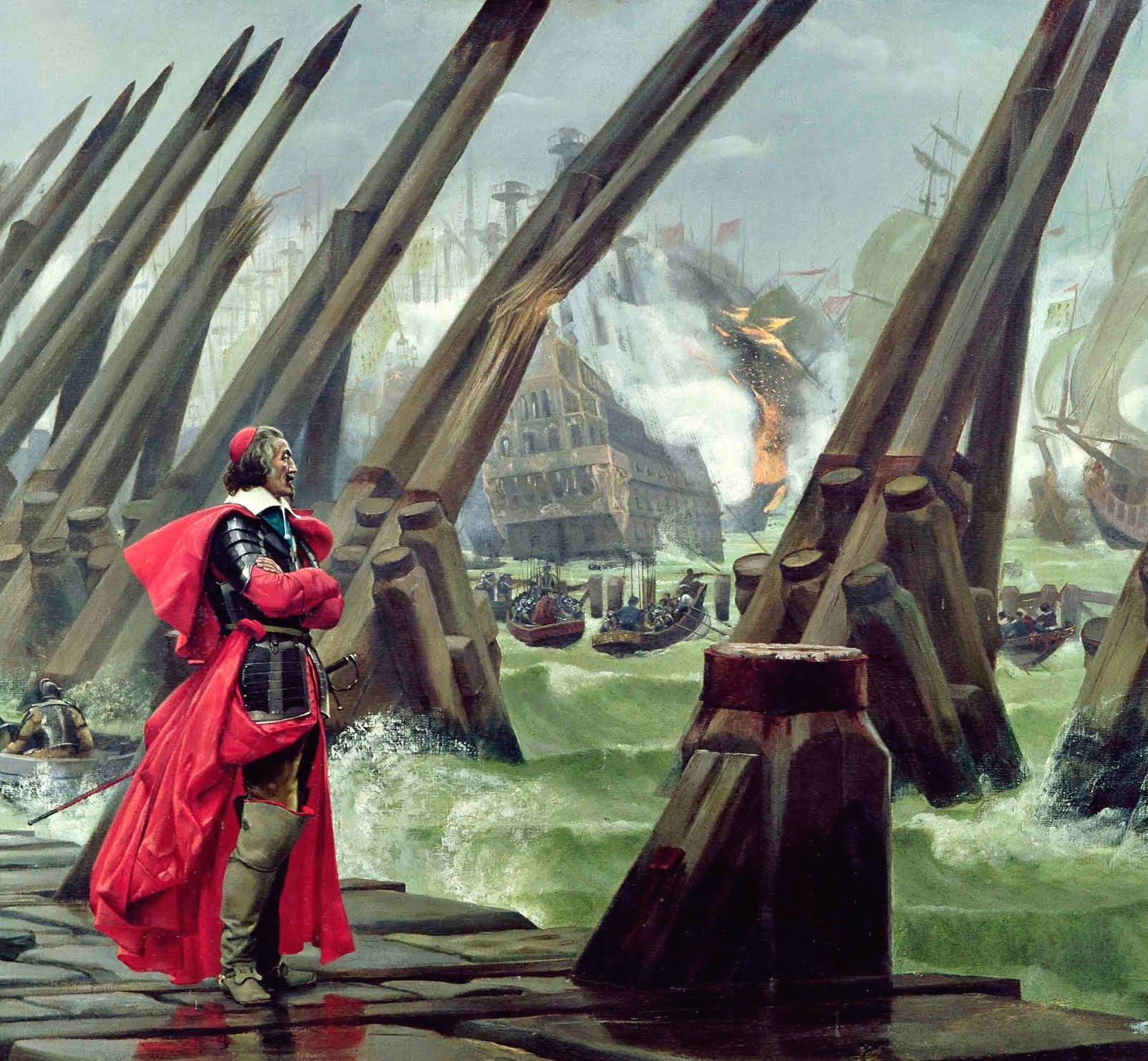 Cardinal Richelieu at the Siege of La Rochelle against the Huguenots, Henri Motte, 1881.
Cardinal Richelieu at the Siege of La Rochelle against the Huguenots, Henri Motte, 1881.In
France, the
Protestant Huguenots, mainly located in the southwestern provinces, revolted against the
central Royal power of the French government. The uprising followed the death of
Henry IV, who, himself originally a
Huguenot before converting to
Catholicism, had protected
Protestants through
the Edict of Nantes. The new ruler however,
Louis XIII, under the regency of his Italian Catholic mother
Marie de' Medici, became more intolerant of
the Protestant religion. The
Huguenots tried to respond by defending themselves, establishing independent political and military structures, establishing diplomatic contacts with foreign powers, and openly revolting against central power. The Huguenot rebellions came after two decades of internal peace under
Henry IV, following the intermittent
French Wars of Religion of
1562–1598. The rebellion led to major military encounters, which ended in defeat for the
Huguenots:
the Siege of Montauban,
the Naval battle of Saint-Martin-de-Ré on 27 October 1622,
the Capture of Ré island in 1625, and
the Siege of La Rochelle in 1627-1628 which became an international conflict with the involvement of
England in
the Anglo-French War (1627-1629). The House of
Stuart in
England had been involved in attempts to secure peace in Europe (through the Spanish Match) and had intervened in
the 30 Years' War against both
Spain and
France. However, due in part to the scale of the defeat (which indirectly lead to the assassination of the English leader the
Duke of Buckingham), and also due to the lack of funds for war, which stemmed from internal conflict between
Charles I and
his Parliament,
England stopped being involved in European affairs, to the dismay of
Protestant forces on the continent.
France remained the largest Catholic kingdom that was not only not aligned with
the Habsburg powers but would come to actively wage war against
Spain. The French Crown's response to
the Hugeunot rebellion was not so much a representation of the typical religious polarisation of
the Thirty Years' War, but rather the attempts at achieving national hegemony by
absolutist monarchy.
Danish intervention (1625–1629) King Christian IV of Denmark, General of the Lutheran army.
King Christian IV of Denmark, General of the Lutheran army.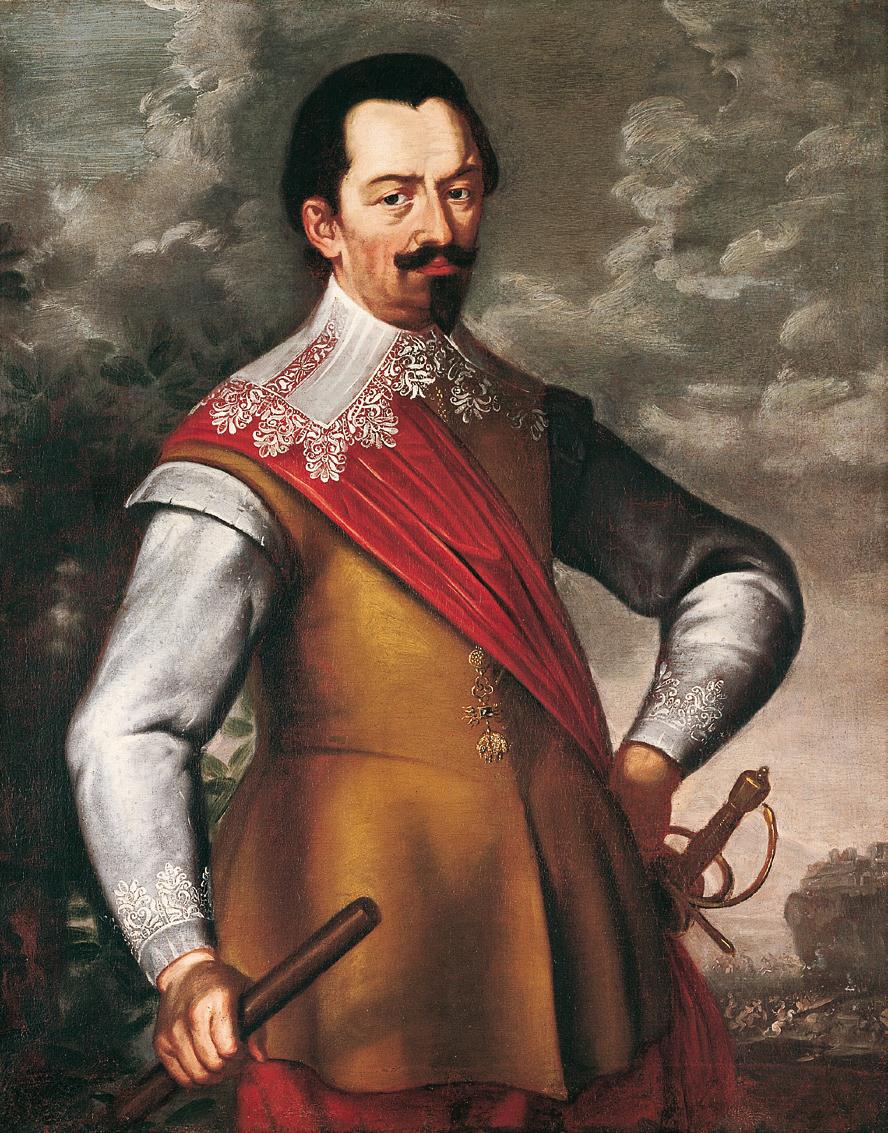 Catholic General Albrecht von Wallenstein.
Catholic General Albrecht von Wallenstein.Peace in the Empire was short-lived, however, as conflict resumed at the initiation of
Denmark. Danish involvement, referred to as
Low Saxon War or Kejserkrigen ("Emperor's War"), began when
Christian IV of Denmark, a Lutheran who was also the
Duke of Holstein, a duchy within the Holy Roman Empire, helped
the Lutheran rulers of neighbouring
Lower Saxony by leading an army against the Imperial forces.
Denmark had feared that its sovereignty as a Protestant nation was threatened by the recent Catholic successes.
Christian IV had also profited greatly from his policies in
northern Germany. For instance, in 1621,
Hamburg had been forced to accept
Danish sovereignty and Christian's second son was made bishop of
Bremen.
Christian IV had obtained for his kingdom a level of stability and wealth that was virtually unmatched elsewhere in Europe. This stability and wealth was paid for by tolls on the
Oresund and also by extensive war reparations from
Sweden.
Denmark's cause was aided by
France which, together with
England, had agreed to help subsidize the war.
Christian had himself appointed war leader of
the Lower Saxon Circle and raised an army of 20,000 mercenaries and a national army 15,000 strong.
To fight him,
Ferdinand II employed the military help of
Albrecht von Wallenstein, a Bohemian nobleman who had made himself rich from the confiscated estates of his countrymen.
Wallenstein pledged his army, which numbered between 30,000 and 100,000 soldiers, to
Ferdinand II in return for the right to plunder the captured territories.
Christian, who knew nothing of
Wallenstein's forces when he invaded, was forced to retire before the combined forces of
Wallenstein and
Tilly.
Christian's poor luck was with him again when all of the allies he thought he had were forced aside:
England was weak and internally divided,
France was in the midst of a civil war,
Sweden was at war with
the Polish-Lithuanian Commonwealth, and neither
Brandenburg nor
Saxony were interested in changes to the tenuous peace in
eastern Germany.
Wallenstein defeated
Mansfeld's army at
the Battle of Dessau Bridge (1626) and General
Tilly defeated
the Danes at
the Battle of Lutter (1626).
Mansfeld died some months later of illness, apparently tuberculosis, in
Dalmatia.
Wallenstein's army marched north, occupying
Mecklenburg,
Pomerania, and ultimately
Jutland itself. However, he was unable to take the Danish capital on the island of
Zealand.
Wallenstein lacked a fleet, and neither the Hanseatic ports nor the Poles would allow an Imperial fleet to be built on the Baltic coast. He then laid siege to
Stralsund, the only belligerent Baltic port with the facilities to build a large fleet. However, the cost of continuing the war was exorbitant compared to what could possibly be gained from conquering the rest of
Denmark.
Wallenstein feared to lose his
North German gains to a
Danish-Swedish alliance, and
Christian IV had suffered another defeat in
the Battle of Wolgast, so both were ready to negotiate.
Negotiations were concluded with
the Treaty of Lübeck in 1629, which stated that
Christian IV could keep his control over
Denmark if he would abandon his support for
the Protestant German states. Thus, in the following two years more land was subjugated by
the Catholic powers. At this point,
the Catholic League persuaded
Ferdinand II to take back
the Lutheran holdings that were, according to
the Peace of Augsburg, rightfully the possession of
the Catholic Church. Enumerated in
the Edict of Restitution (1629), these possessions included two Archbishoprics, sixteen bishoprics, and hundreds of monasteries. The same year,
Gabriel Bethlen, the Calvinist Prince of
Transylvania, died. Only the port of Stralsund continued to hold out against Wallenstein and the Emperor.
Swedish intervention (1630–1635) Cardinal-Infante Ferdinand of Spain, commander of the Spanish and Imperial armies.
Cardinal-Infante Ferdinand of Spain, commander of the Spanish and Imperial armies. The Battle of Breitenfeld (1631)
The Battle of Breitenfeld (1631)Some within
Ferdinand II's court did not trust
Wallenstein, believing that he sought to join forces with
the German Princes and thus gain influence over the Emperor.
Ferdinand II dismissed
Wallenstein in 1630. He was to later recall him after the Swedes, led by King
Gustaf II Adolf (Gustavus Adolphus), had invaded the Holy Roman Empire with success and turned the tables on the Catholics. His contributions made
Sweden the continental leader of
Protestantism until the Swedish Empire ended in 1721.
Gustavus Adolphus, like
Christian IV before him, came to aid the
German Lutherans, to forestall Catholic aggression against their homeland, and to obtain economic influence in the German states around the Baltic Sea. In addition,
Gustavus was concerned about the growing power of
the Holy Roman Empire. No one knows the exact reason for
Gustavus to enter the war and this has been widely argued. Like
Christian IV,
Gustavus Adolphus was subsidized by
Cardinal Richelieu, the Chief Minister of
Louis XIII of
France, and by
the Dutch. From 1630 to 1634, Swedish-led armies drove the Catholic forces back, regaining much of the lost Protestant territory. During his campaign he managed to conquer half of the Imperial kingdoms.
Swedish forces entered the Holy Roman Empire via the Duchy of
Pomerania, which served as the Swedish bridgehead since
the Treaty of Stettin (1630). After dismissing
Wallenstein in 1630,
Ferdinand II became dependent on
the Catholic League.
Gustavus Adolphus allied with
France in
the Treaty of Bärwalde (January 1631).
France and
Bavaria signed
the secret Treaty of Fontainebleau (1631), but this was rendered irrelevant by Swedish attacks against
Bavaria. At
the Battle of Breitenfeld (1631),
Gustavus Adolphus's forces defeated the Catholic League led by
General Tilly. A year later they met again in another Protestant victory, this time accompanied by the death of
Tilly. The upper hand had now switched from the league to the union, led by
Sweden. In 1630,
Sweden had paid at least 2,368,022 daler for its army of 42,000 men. In 1632, it contributed only one-fifth of that (476,439 daler) towards the cost of an army more than three times as large (149,000 men). This was possible due to subsidies from
France, and the recruitment of prisoners (most of them taken at
the Battle of Breitenfeld) into the Swedish army. The majority of mercenaries recruited by
Gustavus II Adolphus were German but Scottish mercenaries were also common. With
Tilly dead,
Ferdinand II returned to the aid of
Wallenstein and his large army.
Wallenstein marched up to the south, threatening
Gustavus Adolphus's supply chain.
Gustavus Adolphus knew that
Wallenstein was waiting for the attack and was prepared, but found no other option.
Wallenstein and
Gustavus Adolphus clashed in
the Battle of Lützen (1632), where the
Swedes prevailed, but
Gustavus Adolphus was killed.
Ferdinand II's suspicion of
Wallenstein resumed in 1633, when
Wallenstein attempted to arbitrate the differences between the
Catholic and
Protestant sides.
Ferdinand II may have feared that
Wallenstein would switch sides, and arranged for his arrest after removing him from command. One of Wallenstein's soldiers,
Captain Devereux, killed him when he attempted to contact the Swedes in the town hall of Eger (Cheb) on 25 February 1634. The same year, the Protestant forces, lacking Gustav's leadership, were defeated at
the First Battle of Nördlingen by the Spanish-Imperial forces commanded by
Cardinal-Infante Ferdinand.
 The victory of Gustavus Adolphus at the Battle of Breitenfeld (1631).
The victory of Gustavus Adolphus at the Battle of Breitenfeld (1631).By the Spring of 1635, all Swedish resistance in the south of
Germany had ended. After that, the two sides met for negotiations, producing
the Peace of Prague (1635), which entailed a delay in the enforcement of
the Edict of Restitution for 40 years and allowed Protestant rulers to retain secularized bishoprics held by them in 1627. This protected
the Lutheran rulers of northeastern Germany, but not those of the south and west (whose lands had been occupied by the Imperial or League armies prior to 1627).
The treaty also provided for the union of the army of the Emperor and the armies of the German states into a single army of the Holy Roman Empire (although Johann Georg of Saxony and Maximillian of Bavaria kept, as a practical matter, independent command of their forces, now nominally components of the "Imperial" army). Finally, German princes were forbidden from establishing alliances amongst themselves or with foreign powers, and amnesty was granted to any ruler who had taken up arms against the Emperor after the arrival of the Swedes in 1630.
This treaty failed to satisfy France, however, because of the renewed strength it granted the Habsburgs. France then entered the conflict, beginning the final period of the Thirty Years' War.
French intervention (1635–1648)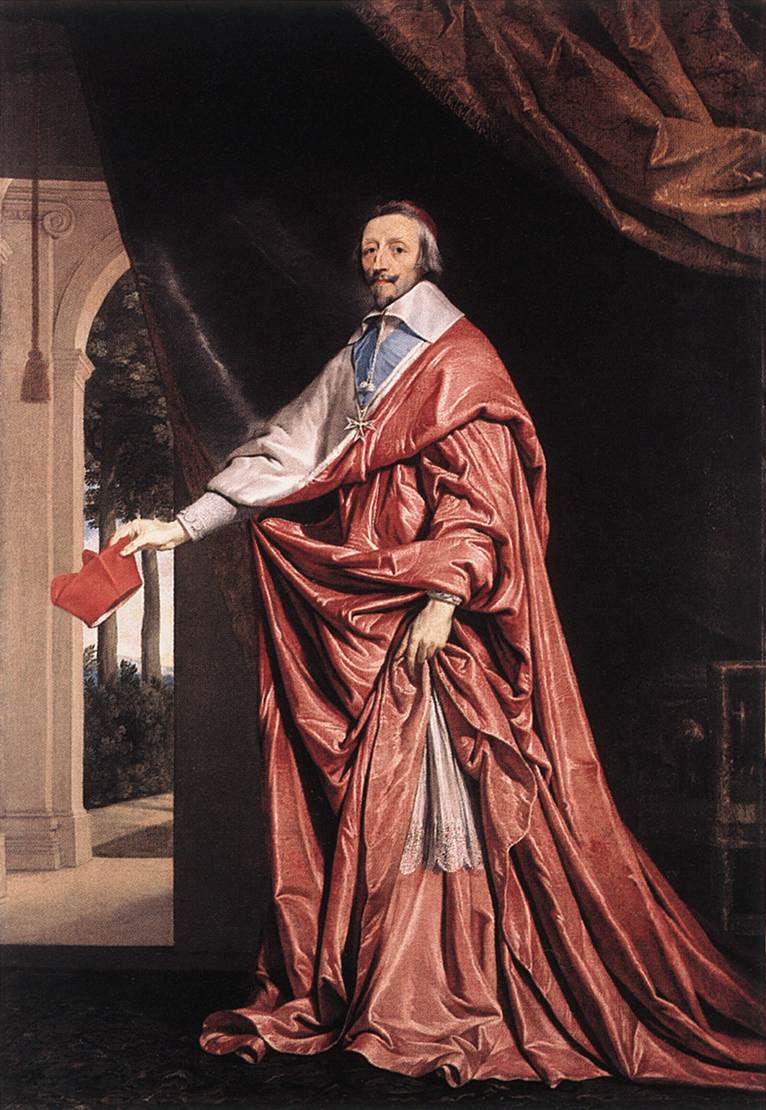 Although a Catholic clergyman himself, Cardinal Richelieu allied France with the Protestants.
Although a Catholic clergyman himself, Cardinal Richelieu allied France with the Protestants.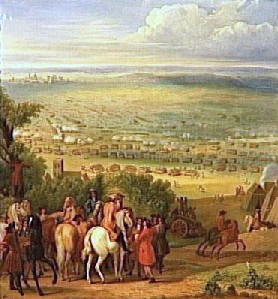 The Battle of Lens, 1648. Torstenson 1642
The Battle of Lens, 1648. Torstenson 1642France, although Roman Catholic, was a rival of the Holy Roman Empire and Spain. Cardinal Richelieu, the Chief Minister of King Louis XIII of France, felt that the Habsburgs were too powerful, since they held a number of territories on France's eastern border, including portions of the Netherlands. Richelieu had already begun intervening indirectly in the war in January 1631, when the French diplomat Hercules de Charnace signed the Treaty of Bärwalde with Gustavus Adolphus, by which France agreed to support the Swedes with 1,000,000 livres each year in return for a Swedish promise to maintain an army in Germany against the Habsburgs. The treaty also stipulated that Sweden would not conclude a peace with the Holy Roman Emperor without first receiving France's approval.
After the Swedish rout at Nördlingen in September 1634 and the Peace of Prague in 1635, as Sweden's ability to continue the war alone appeared doubtful, Richelieu made the decision to enter into direct war against the Habsburgs. France declared war on Spain in May 1635 and the Holy Roman Empire in August 1636, opening offensives against the Habsburgs in Germany and the Low Countries. France aligned her strategy with the allied Swedes in Wismar (1636) and Hamburg (1638).
French military efforts met with disaster, and the Spanish counter-attacked, invading French territory. The Imperial general Johann von Werth and Spanish commander Cardinal-Infante Ferdinand of Spain ravaged the French provinces of Champagne, Burgundy and Picardy, and even threatened Paris in 1636 before being repulsed by Bernhard of Saxe-Weimar. Bernhard's victory in the Battle of Compiègne pushed the Habsburg armies back towards the borders of France. Widespread fighting ensued, with neither side gaining an advantage. In 1642, Cardinal Richelieu died. A year later, Louis XIII died, leaving his five-year-old son Louis XIV on the throne. His chief minister, Cardinal Mazarin, facing the domestic crisis of the Fronde in 1645, began working to end the war.
In 1643, the Swedish marshal Lennart Torstenson expelled Danish prince Frederick from Bremen-Verden, gaining a stronghold south of Denmark and hindering Danish participation as mediatiors in the peace talks in Westphalia.[42] In 1645, Torstenson defeated the Imperial army at the Battle of Jankau near Prague, and Louis II de Bourbon, Prince de Condé defeated the Bavarian army in the Second Battle of Nördlingen. The last Catholic commander of note, Baron Franz von Mercy, died in the battle.
On 14 March 1647
Bavaria,
Cologne,
France and
Sweden signed
the Truce of Ulm. In 1648 the Swedes (commanded by Marshal Carl Gustaf Wrangel) and the French (led by Turenne and Condé) defeated the Imperial army at the Battle of Zusmarshausen and Lens. These results left only the Imperial territories of Austria safely in Habsburg hands.
Peace of WestphaliaFrench General Louis II de Bourbon, 4th Prince de Condé, Duc d'Enghien, The Great Condé defeated the Spanish at the Battle of Rocroi in 1643, which led to negotiations. Over a four year period, the parties were actively negotiating at Osnabrück and Münster in Westphalia. The end of the war was not brought about by one treaty but instead by a group of treaties such as the Treaty of Hamburg. On 15 May 1648, the Treaty of Osnabrück was signed. Over five months later, on 24 October, the Treaty of Münster was signed, ending both the Thirty Years' War and the Eighty Years' War.
Casualties and diseaseSo great was the devastation brought about by the war that estimates put the reduction of population in the German states at about 15% to 30%. Some regions were affected much more than others. For example, Württemberg lost three-quarters of its population during the war. In the territory of Brandenburg, the losses had amounted to half, while in some areas an estimated two-thirds of the population died. The male population of the German states was reduced by almost half. The population of the Czech lands declined by a third due to war, disease, famine and the expulsion of Protestant Czechs. Much of the destruction of civilian lives and property was caused by the cruelty and greed of mercenary soldiers, many of whom were rich commanders and poor soldiers. Villages were especially easy prey to the marauding armies. Those that survived, like the small village of Drais near Mainz would take almost a hundred years to recover. The Swedish armies alone may have destroyed up to 2,000 castles, 18,000 villages and 1,500 towns in Germany, one-third of all German towns. The war caused serious dislocations to both the economies and populations of central Europe, but may have done no more than seriously exacerbate changes that had begun earlier.
Pestilence of several kinds raged among combatants and civilians in Germany and surrounding lands from 1618 to 1648. Many features of the war spread disease. These included troop movements, the influx of soldiers from foreign countries, and the shifting locations of battle fronts. In addition, the displacement of civilian populations and the overcrowding of refugees into cities led to both disease and famine. Information about numerous epidemics is generally found in local chronicles, such as parish registers and tax records, that are often incomplete and may be exaggerated. The chronicles do show that epidemic disease was not a condition exclusive to war time, but was present in many parts of Germany for several decades prior to 1618.
However, when the Danish and Imperial armies met in
Saxony and
Thuringia during 1625 and 1626,
disease and
infection in local communities increased. Local chronicles repeatedly referred to "
head disease", "
Hungarian disease", and a "
spotted" disease identified as
typhus. After
the Mantuan War, between
France and
the Habsburgs in
Italy, the
northern half of the Italian peninsula was in the throes of a
bubonic plague epidemic. During the unsuccessful siege of
Nuremberg, in 1632, civilians and soldiers in both the Swedish and Imperial armies succumbed to typhus and scurvy. Two years later, as the Imperial army pursued the defeated Swedes into southwest
Germany, deaths from epidemics were high along the
Rhine River. Bubonic plague continued to be a factor in the war. Beginning in 1634,
Dresden,
Munich, and smaller German communities such as
Oberammergau recorded large numbers of
plague casualties. In the last decades of the war, both typhus and dysentery had become endemic in
Germany.
Political consequences Damages in Germany's population as percentupload.wikimedia.org/wikipedia/commons/7/7d/Holy_Roman_Empire_1648.svgCentral Europe at the end of the Thirty Years' War, showing the fragmentation that resulted in decentralization.
Damages in Germany's population as percentupload.wikimedia.org/wikipedia/commons/7/7d/Holy_Roman_Empire_1648.svgCentral Europe at the end of the Thirty Years' War, showing the fragmentation that resulted in decentralization.One result of the war was the division of Germany into many territories — all of which, despite their membership in the Empire, won de facto sovereignty. This limited the power of the Holy Roman Empire and decentralized German power.
The Thirty Years' War rearranged the European power structure.
The conflict made Spain's military and political decline visible. While
Spain was fighting in
France,
Portugal — which had been under personal union with
Spain for 60 years — acclaimed
John IV of
Braganza as king in 1640, and the
House of Braganza became
the new dynasty of Portugal. Meanwhile,
Spain was forced
to accept the independence of the Dutch Republic in 1648, ending the Eighty Years' War.
France gradually began to replace a weakening
Spain in influence, beginning with
the Franco-Spanish War (1635-59) and confirmed by
the War of Devolution and
the Franco-Dutch War. Even before the last three decades of the century, it was undeniable that
Bourbon France, under the leadership of
Louis XIV, had surpassed a declining
Habsburg Spain as Europe's leading power.
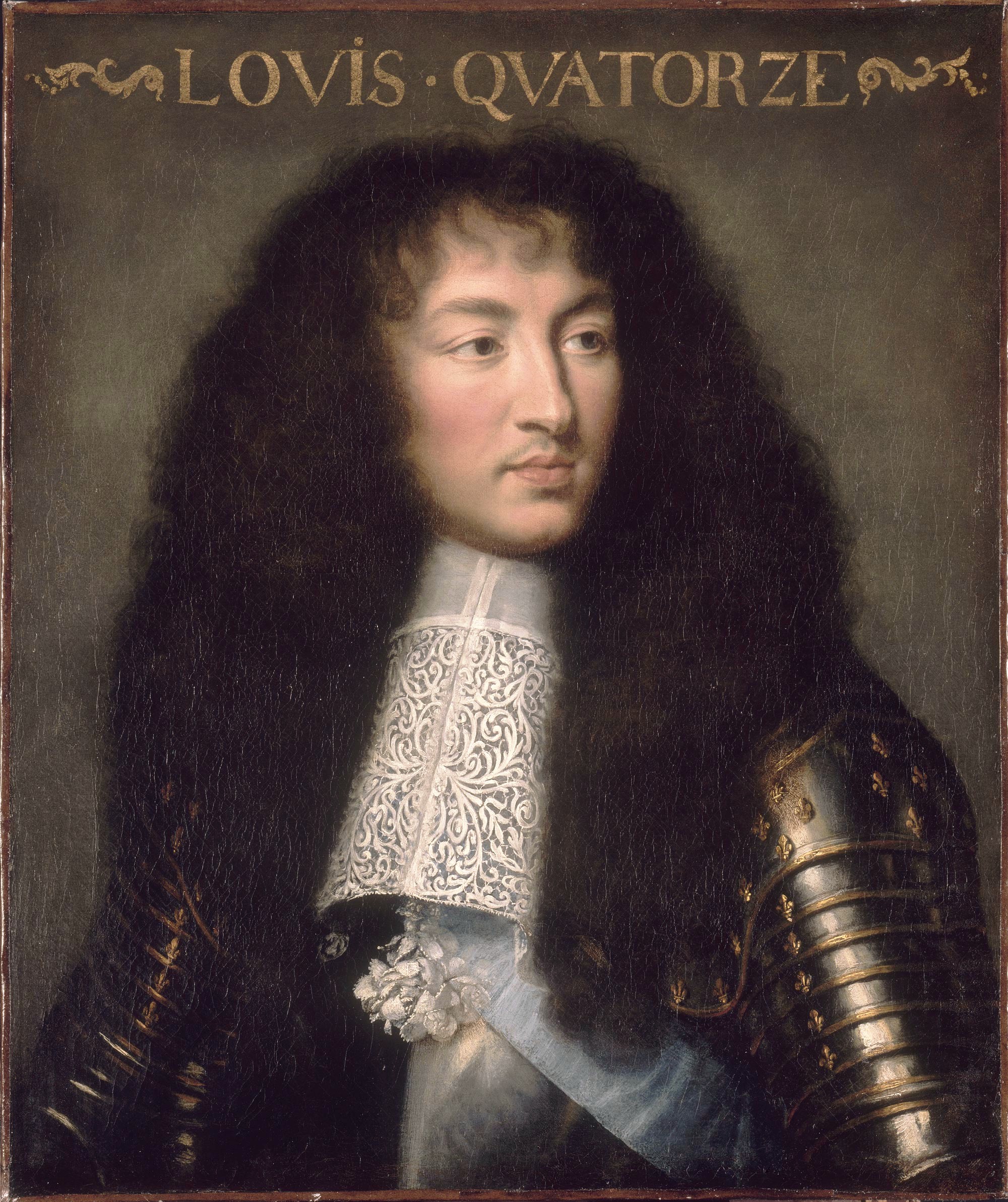 Louis XIV, le Roi Soleil, le Grand
Louis XIV, le Roi Soleil, le GrandFrom 1643–45, during the last years of
the Thirty Years' War,
Sweden and
Denmark fought the Torstenson War. The result of that conflict and the conclusion of the great European war at
the Peace of Westphalia in 1648 helped establish
post-war Sweden as a force in Europe.
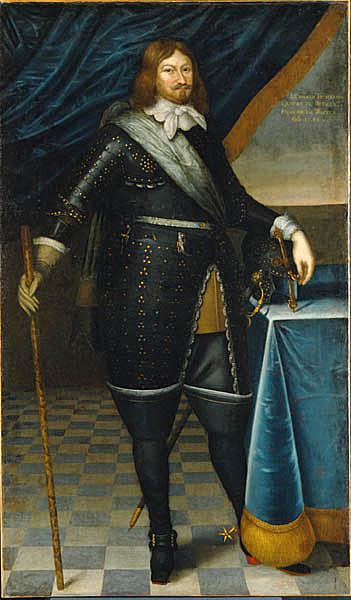 Lennart Torstenson, Count of Ortala, Baron of Virestad (17 August 1603 – 7 April 1651), was a Swedish Field Marshal and military engineer.
Lennart Torstenson, Count of Ortala, Baron of Virestad (17 August 1603 – 7 April 1651), was a Swedish Field Marshal and military engineer.The edicts agreed upon during the signing of
the Peace of Westphalia were instrumental in laying the foundations for what are even today considered the basic tenets of the sovereign nation-state. Aside from establishing fixed territorial boundaries for many of the countries involved in the ordeal (as well as for the newer ones created afterwards),
the Peace of Westphalia changed the relationship of subjects to their rulers. In earlier times, people had tended to have overlapping political and religious loyalties. Now, it was agreed that the citizenry of a respective nation were subjected first and foremost to the laws and whims of their own respective government rather than to those of neighboring powers, be they religious or secular.
The war also has a few more subtle consequences.
The Thirty Years' War marked the last major religious war in mainland Europe, ending the large-scale religious bloodshed accompanying
the Reformation, in 1648. There were other religious conflicts in the years to come, but no great wars. Also, the destruction caused by mercenary soldiers defied descriptio. The war did much to end the age of mercenaries that had begun with the first Landsknechts, and ushered in the age of well-disciplined national armies.
The war also had consequences abroad, as the European powers extended their fight via naval power to overseas colonies.
In 1630, a Dutch fleet of 70 ships had taken the rich sugar-exporting areas of Pernambuco (Brazil) from the Portuguese but had lost everything by 1654. Fighting also took place in
Africa and
Asia.

